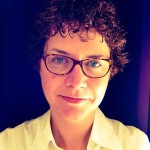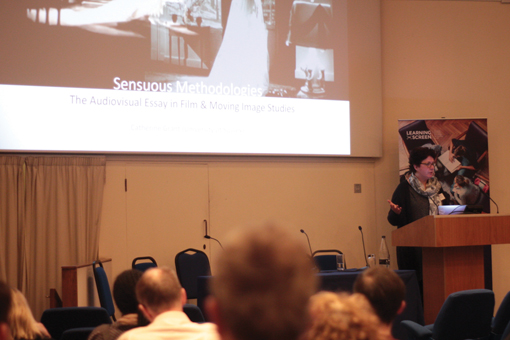Creative Possibilities
Dr Catherine Grant, University of Sussex, speaks with Dr Amber Jacobs and PhD student Ian Magor about their experiences exploring and explaining film with the audiovisual essay.
 About the Author: Dr Catherine Grant is currently Senior Lecturer in Film Studies at the University of Sussex. Her research explores audiovisual approaches to film and moving image studies. In September 2017, Grant will take up a new post as Professor of Digital Media and Screen Studies at Birkbeck, University of London. Her video essay work, and her writings on these forms are linked to at her personal website: catherinegrant.org.
About the Author: Dr Catherine Grant is currently Senior Lecturer in Film Studies at the University of Sussex. Her research explores audiovisual approaches to film and moving image studies. In September 2017, Grant will take up a new post as Professor of Digital Media and Screen Studies at Birkbeck, University of London. Her video essay work, and her writings on these forms are linked to at her personal website: catherinegrant.org.
Audiovisual Methods in Screen Studies
Since 2009, I have been exploring the use of video essays in film and television studies research and teaching. I am interested in these digitally-produced, found-footage based works as highly effective expressive or argumentative forms, as alternatives or supplements to written essays on moving image subjects. But I have found myself most drawn to the audiovisual research methods they involve, in other words to the analytical, critical and creative possibilities offered by non-linear viewing and editing technologies.

Dr Catherine Grant speaking about the audiovisual essay at Learning on Screen’s AGM event in December 2016.
I am often invited to run workshops on these ‘material-thinking’-based methods. Over the last four years I have led a three-hour long session introducing their use on an option on the MA Psychosocial Studies at Birkbeck, University of London. This has been an especially fascinating experience for me as it is (in part) a screen theory-based course taken by students with little or no previous film studies or film practice experience. I show my audiovisual essay work, talk about its aims and the often quite rudimentary methods it involves, and answer questions about it. No detailed technical training or specialised equipment are offered. Students were at first encouraged, and now are compelled, to explore these audiovisual techniques to produce edited material for their class presentations. In my view, much of the work produced has been extremely fruitful in critical and creative terms. In what follows, I interview Dr Amber Jacobs (the teacher of the module) and Ian Magor (a student who took it) about their experience of the introduction of these methods to this class.
I’ve been drawn to the analytical, critical and creative possibilities offered by non-linear viewing and editing…
Dr Amber Jacobs: The course is an MA option called Visual Culture: Power and the Image. The students were all from Psychosocial Studies, Psychoanalysis and History. We even had some Medical Humanities and Creative Writing students. A real range of students, few of whom had ever done any kind of audiovisual remixing or editing. Their only relation to the audiovisual is as spectators who don’t ‘mess with things’, who just watch. The reason why I introduced these methods was because I was inspired by your work.
What I wanted to achieve was a different form of investigation, to get away from a kind of textual or literary relationship to images. I wanted the specificity of the medium to be taken into greater account. You can do that theoretically and intellectually to a certain extent. But, in the end, I found that, especially with these students who are used to examining cultural objects as if they were texts, the audiovisual specificity almost always gets lost. So, there was a desire to make students more alert to the specificity of the medium, to encourage them to be more active in relation to it. I did take a risk at the beginning of the course because of how phobic people are about technology. We had one workshop with you to start with, which set up the whole notion of material thinking, and gave some information about how to make video essays. Then I gave them the option to think about their presentations in this hands-on, material way. It was a way of trying to shift the whole underpinning of the course towards thinking differently about how knowledge is produced. To allow students to move from being textual critics to makers of images. That was the rationale. The results have been consistently amazing. From that first year, it became even more integrated into the course, and this year they have had to make at least one video essay. They feel so proud about being able to make something, rather than just being a critic. A student on the first running of the workshop, Ian Magor, is the absolute proof of how generative that was and continues to be.
Catherine Grant: Ian, had you come across anything like this before the class?
Ian Magor: No. I felt it was something we should try, even if, in my year, it wasn’t compulsory. I was fortunate to team up with somebody in the class who had some experience of film editing. Because of that he sat at the control desk. But it was wonderful for me because I was able to throw all these suggestions at him about what we could do with things, with music, and cutting, with taking away voices, with speeding up and slowing down scenes, and he would just do it. I learned fairly quickly about how to do things. It was just like applying skills from other digital activities like cutting and pasting in word processing, or overlaying in image editing. For me it was a way of enabling you to write about film, because suddenly, rather than poring over ways of describing why you think one scene is similar to another, you just stick them side by side, watch them, and then write about your visual experience of that. So, it also opened up being able to write about film for me.
AJ: You really took to it as a mode. You completely understood that sequential or associative way of thinking (that psychoanalytic thinking itself utilises). Some students have more of an issue with trying to understand how the video essay can represent a different mode of thinking. Juxtaposing things is a form of writing, a form of inscription.
IM: I think for me it unleashed a little bit of a torrent. I’d wanted to write about film for a long time but felt very frustrated at trying to get it down in words. When I read about film I get very bored with plot synopses, and why a character did something to another character. I wanted to treat film differently but didn’t really know how to. I think I had all these things that I wanted to say, but I hadn’t found the medium. Being able to do this really worked for me.
CG: At what stage did you feel confident enough to do the editing yourself?
IM: After about two weeks!
AJ: What you said about how you’d been frustrated about writing about films and about how there’s so much describing the plot or analysing characters, that’s exactly what I mean about trying to get students to move away from that literary type of analysis. Also, about using film theory or psychoanalysis to ‘understand’ characters: that theory/application model is so not what I want to promote or teach. Making videos using footage from the films provides a check on doing that because you are so involved with the formal aspects of the audiovisual medium. This is exactly why this practice-based work is helping to produce a much deeper understanding from the inside about how it works, both affectively and ideologically.
Dr Catherine Grant
Amber Jacobs is Senior Lecturer in Psychosocial Studies at Birkbeck, University of London. Her recent research is on audiovisual culture, film theories, the relation between new media technologies and unconscious fantasy, and theories of feminist and queer spectatorship. She also makes her own films, and radio and video essays.
Ian Magor is a PhD student at Birkbeck, University of London. His research examines the pooling of expertise between American psychiatrists, filmmakers and the military during the Second World War and its influence on Cold War concepts of brainwashing and thought control. His video essay work can be found at vimeo.com/ianmagor.
 Learning on Screen
Learning on Screen